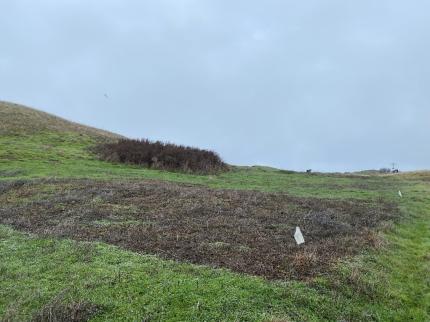Managing Wildlife Populations
Sea duck, Marine Bird Surveys: Biologist Murphie participated in the annual Puget Sound Ecosystem Monitoring Program winter marine bird and mammal survey effort, as a primary observer. These surveys have been conducted since 1992 and sample the inland marine waters of Washington. Biologist Murphie has participated in this effort since 1995. Observers identify and count all birds and marine mammals seen within a fifty-meter strip on either side of the survey aircraft. The current survey track line extends about 4,000 miles. So far, the crew has completed about 65% of the effort. The figure below shows the track lines covered so far (blue lines) and the track lines remaining (red lines), as of Jan. 4.

Grouse Wing and Tail Collection Barrels: Biologist Murphie placed grouse wing collection barrels at two locations in District 15 prior to the grouse season opener in September. They are located at Simpson Mill 5 near Matlock and at the George Adams Hatchery north of Shelton. Twenty-four samples have been collected this season, but none in recent weeks.
Goose Surveys: Biologist Cent and Novack conducted their bi-monthly surveys of dusky Canada goose across Grays Harbor and Pacific counties.
Swan Surveys: Biologist Cent conducted District 17’s annual tundra and trumpeter swan count, where she counted a total of 52 swans. This count is low, and Biologist Cent plans to survey a second time to confirm these numbers. Sometimes the swans are simply in a location that we are unaware of or do not have access to.
Brant Survey: Biologist Novack and Cent, along with Waterfowl Section Manager Spragens, conducted the annual survey of Brant at Willapa Bay. Just shy of 3,000 Brant were seen, which is well in line with prior years. Brant have been surveyed on an annual basis at Willapa Bay since 1959.
Providing Recreation Opportunities
Treponeme-associated Hoof Disease Permit Hunters: Biologist Novack has checked the hooves from various Master Hunter permittees and issued renewal letters for those submitting abnormal hooves. The renewal letters allow the Master Hunter to use their unused general season tag to try and harvest a 2nd treponeme-associated hoof disease infected elk.
Conserving Natural Landscapes
Morse Creek Cleanup: Wildlife Area Manager Laushman and Officer Lasko cleaned up an illegal campsite and debris located in the Morse Creek Unit.
Protection Island Visit: Technician Norris and Wildlife Area Manager Laushman visited the Zella Schultz Unit on Protection Island to assess recent work on invasive species and transplanted dune grasses.

Scatter Creek Wildlife Area: Biologist Kronland, Scatter Creek Wildlife Area staff members, Washington Conservation Corps crews, and Ecostudies partners have been able to treat non-native vegetation and seed and plant plugs on all five units burned this summer on the West Rocky and Scatter Creek units of the wildlife area, setting-us up for a fantastic spring show of prairie blooms.
We have also been able to take advantage of fantastic fire effects from the previous burn season and sow additional seed into units burned in 2022. The efforts have gone far in enhancing habitat for federally listed Taylor’s checkerspot butterfly, Mazama pocket gopher, and all the other critters and plants that call the prairie and oak lands of the Scatter Creek Wildlife Area home, which we guess now includes bluegill.
Seemingly random flash flood events have been inundating the mima mounds on some of our post-prescribed fire restoration sites, leaving behind piles of fresh water pan fish and the lingering question of where they came from. So, find your bobbers, get some red worms, and come out to Scatter Creek to catch yourself a mess of prairie bluegill! But be quick, because the surface water doesn’t flow for long and you may need to rake them up instead.


Providing Education and Outreach
General Wildlife Inquiries: Biologist Murphie responded to inquiries received by phone and email related to elk, deer, and duck hunting, grouse hunting, an osprey nest removal request, a sick Canada goose, fencing, and eastern gray squirrel.
Other
Snow Creek Site Visit: Wildlife Area Manager Laushman and Technician Stoneburner attended a group field tour led by the North Olympic Salmon Coalition and Jefferson Land Trust to learn about a recent restoration project on Snow Creek just upstream of the Discovery Bay Unit. The project increased stream complexity and reduced erosion and sediment loads in the creek, which will improve salmon habitat throughout the system.
